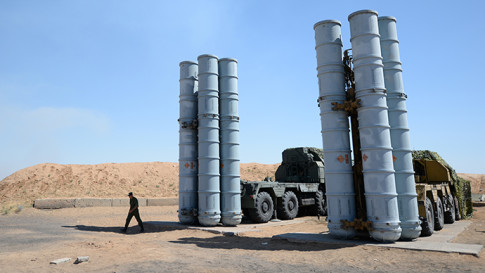
A soldier during a military exercise involving S-300/SA 10 surface-to-air missile systems
– Russian S-300 missile systems capable of targeting near space ‘enter service’ (RT, March 12, 2015):
Near space targets can now be hit by Russian army’s mobile tactical air defense S-300 and S-400 systems as a much anticipated long-range missile enters service. It is designed to engage hard targets such as nuclear warheads, rather than satellites.
The news about a mobile version of an exo-atmospheric missile system has been around since the 1990s, and throughout the 2000s it was expected “in a little while.” But the result obtained is worth the years of hard effort.
The new 40N6 missile guarantees a direct hit on a target at a range of 400 kilometers and at heights of up to 185 kilometers – effectively near space.
This missile’s specialization is not soft targets like low Earth orbit (LEO) satellites with easily intercepted predetermined orbits. The 40N6 missile is capable of exo-atmospheric interception of IRBM (intermediate-range ballistic missile) warheads in their terminal phase, leave alone any aircraft target within the missile range perimeter.
As for securely intercepting warheads of the ICBMs (intercontinental ballistic missile), this task is going to be delegated to the upcoming S-500 Prometheus airspace defense systems that are scheduled to enter service next year.
Reportedly, the final customizing of the 40N6 missile has been going on since 2008, which is explained with extremely challenging assigned task to guarantee the declared target kill altitude at maximum range. The media reported that the 40N6 missile passed final state quality tests in January 2015.
A source in Russia’s Defense Ministry told Tass news agency that the new missile is going to be supplied “primarily to the Western Command,” the regions of Russia bordering NATO member states.
According to the source, the new sophisticated weaponry is “already into mass production.” It is not known at exactly which facility, however.
?????? 40?6 @kolydkapic.twitter.com/3KhwBbPhqq
— ???????? ????????? (@strannik_fizik) March 11, 2015
The 40N6 missile is a genuine breakthrough for Russia’s national airspace defense as it significantly alters the operational capability of missile systems already in service.
Russia possesses approximately 2,000 systems of various modifications of S-300 Favorite and first-rate S-400 Triumph.
One S-400 Triumph battery can attack simultaneously 36 airborne targets with 72 missiles, with a target’s maximum speed of 4.8 kilometers per second.
The S-500 Prometheus is expected to have a range of no less than 600 kilometers and engage targets in low earth orbit flying at speeds of up to 7 kilometers per second, generally the top speed achievable by a ballistic missile at its highest trajectory in space.
Deeply integrated with thousands of other air defense systems scattered throughout the country, they ensure deeply echeloned air defense of all vital military, industrial and administrative installations.
All Russia’s S-300 systems have been upgraded to the latest versions as production of this type of air defense system has been suspended in favor of the manufacturing of the S-400. Now, with the 40N6 missile available, S-300 complexes are getting space defense quality. The 40N6 is also a common missile for combat army and site protection air defense.
Until now Russia’s fourth generation top air defense missile 48N6E2 has had a range of 200 kilometers. With a 400 kilometer range, the 40N6 missile has similar characteristics with the US latest version of sea-based Standard Missile 3 (SM-3) Block IA-IB, which began service in April 2014 after years of hit and miss testing.
The Russian Navy for decades has been operating naval versions of the S-300 system, namely the S-300 Fort F and Fort FM. In 2012, RT reported on the naval version of the S-400 and possibly the S-500 also being developed.
Unlike sea-based (or stationary) SM-3, S-300 and S-400 systems are fully mobile and could be positioned virtually anywhere where tank-based propelling system could take them. This includes their deployment next to national borders, where with the help of 40N6 missile they can seize the initiative hundreds kilometers deep into the air space of neighboring countries.
I don’ think the USA/NATO antagonising of Russia and Nuland/Nudelman’s constant sabre rattling on behalf of Israel is helping here.
These little gems will also probably be availed to both Damascus & Tehran, as they have been targeted accordingly.
The most interesting aspect of this, Vlad’s domestic protective policy, is that Russia also has the capability to attack, yet I’m not aware of similarly adequate protection on the table in Barrie’s USA.
http://rt.com/news/240221-iceland-drop-eu-member/
http://rt.com/politics/239669-crimea-nuclear-weapons-ministry/